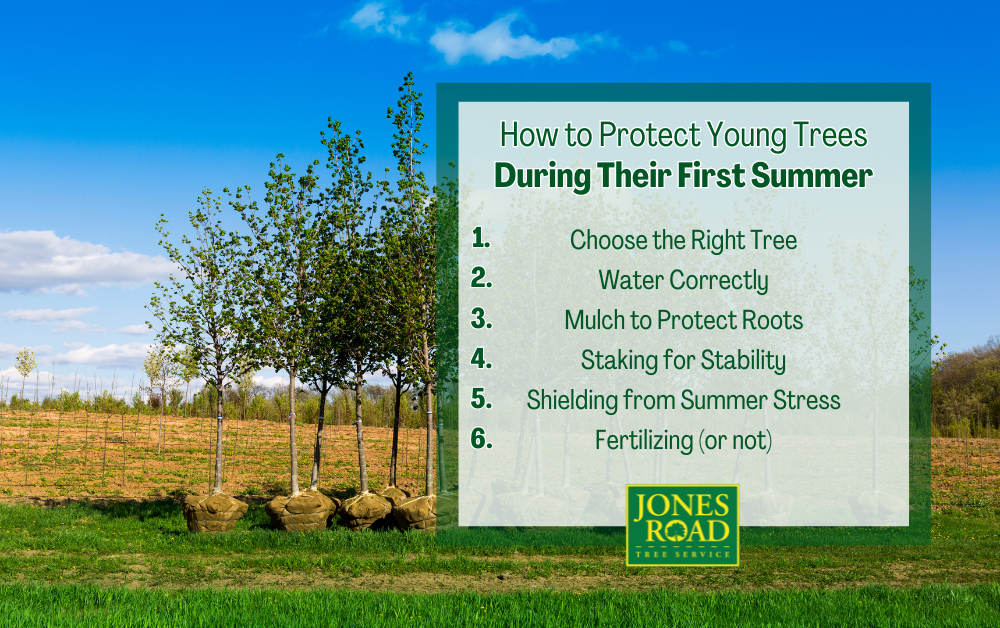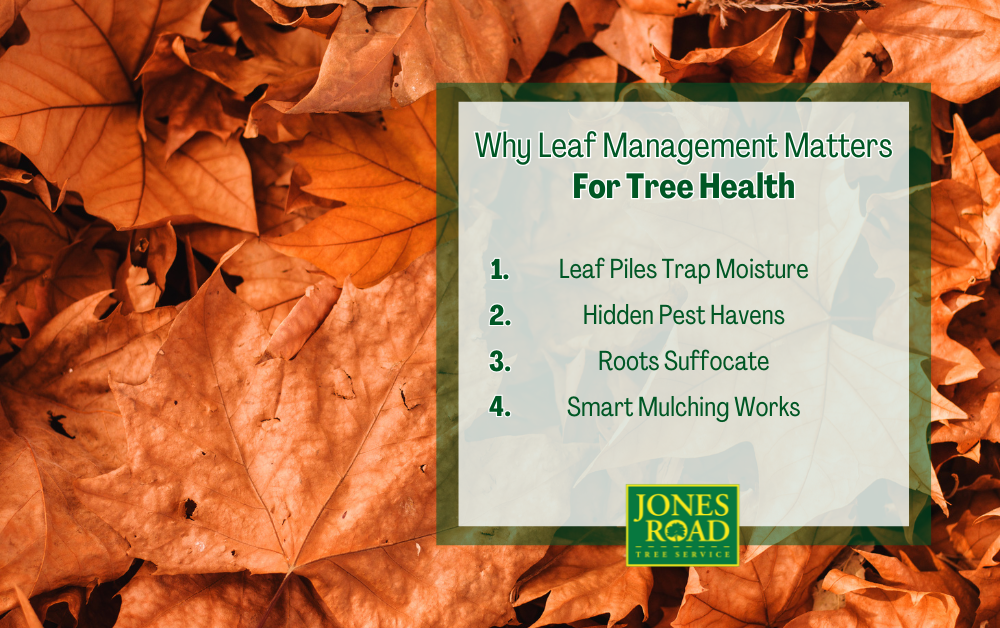Planting a tree is an investment in the future—whether it’s shade for your backyard, beauty for your landscape, or habitat for local wildlife. But once your young trees are in the ground, the real work begins. That first summer is crucial. The heat, unpredictable rain, and harsh sunlight can all be overwhelming for a newly planted tree.
At Jones Road Tree Service, our certified arborist team understands the delicate needs of young trees during their early growth stages. With the right care and a watchful eye, you can ensure your tree thrives—not just survives—through its first hot summer.
1. Choosing the Right Tree for the Right Spot
Sunlight and Soil Matter
Before you even dig that first hole, choosing the right location is key. Trees are living organisms with specific preferences. Some love the sun. Others prefer part shade. Some can tolerate clay-heavy soil, while others need loose, well-drained conditions.
Summer heat can amplify any mistake in site selection. A sun-loving tree in full shade won’t grow well, and a shade-tolerant tree in direct July sun might scorch.
Spacing and Growth Potential
It’s also important to give your new tree room to grow. Planting too close to structures, fences, or other trees can lead to root competition or canopy crowding, which will become a stressor in future seasons.
Consult Before You Plant
If you’re unsure, this is where professional advice makes all the difference. Our arborist at Jones Road Tree Service can evaluate your site, recommend species that will thrive, and ensure your tree is set up for long-term success.
2. Watering Young Trees Correctly
How Much Water Is Enough?
Newly planted trees don’t yet have deep roots to draw water from lower soil levels. That means they rely heavily on consistent, surface-level moisture—especially during hot spells.
A general guideline is 10 to 15 gallons of water per week, depending on tree size and weather. But that’s just a starting point.
Deep vs. Shallow Watering
Many people make the mistake of giving a tree a quick splash from the hose. This only moistens the top inch or two of soil and encourages shallow root growth. Instead, water slowly and deeply, allowing moisture to reach the root ball and surrounding soil.
Signs of Overwatering or Underwatering
- Too much water: Yellowing leaves, soft or mushy soil, and root rot
- Too little water: Wilting, browning, crispy leaves
Both extremes are harmful. Check soil moisture a few inches down to gauge water needs before blindly watering.
Tips for New Tree Irrigation
We recommend using a soaker hose or drip irrigation system to deliver consistent, low-pressure moisture right to the root zone. It’s efficient and prevents runoff—especially useful during hot July afternoons.
3. Mulching to Protect Roots
Benefits of Mulch
Mulch is your tree’s best friend in summer. It insulates the soil, keeps roots cooler, conserves water, and suppresses weeds.
By maintaining steady moisture levels and regulating temperature, mulch reduces stress on the tree, allowing it to focus energy on root establishment.
How to Mulch the Right Way
Apply a 2–4 inch layer of mulch around the base of the tree, spreading it in a donut shape about 2–3 feet wide. Never pile mulch against the trunk—this can lead to rot and pest issues, a mistake often referred to as “volcano mulching.”
Organic vs. Inorganic Mulch
While inorganic mulches like rock or rubber may be long-lasting, they don’t improve soil health. Organic mulch (like shredded bark, wood chips, or composted leaves) decomposes over time and adds nutrients—something our arborist highly recommends for young trees.
4. Staking for Stability (But Not Forever)
When to Stake
Not every young tree needs to be staked. However, in areas with strong winds, loose soil, or if the tree has a weak or uneven trunk, temporary staking can help it stay upright until roots anchor it firmly.
How to Stake Properly
Use two or three stakes placed outside the root ball zone, connected to the trunk with soft, flexible ties that allow some movement. The goal isn’t to lock the tree in place—it needs to sway slightly to strengthen naturally.
When to Remove Stakes
Stakes should never be left on indefinitely. After one full growing season—usually around 12 months—it’s time to reassess. Leaving stakes on too long can girdle the trunk or prevent the tree from developing strong support tissues.
Common Mistakes
- Ties too tight or tied directly to the trunk
- Stakes driven through the root ball
- Using rigid, non-flexible materials
Let our arborist inspect your young tree if you’re unsure whether it needs staking or not.
5. Shielding from Summer Stressors
Sun Scorch and Leaf Burn
Newly planted trees, especially those transplanted from nurseries or shaded environments, can suffer from sun scorch in July. You might notice browning edges, faded spots, or crispy leaves. This is a result of too much direct sunlight before the tree is fully acclimated.
Reflective Barriers and Wraps
Tree wraps and light-colored shields can protect tender bark from sunburn, especially on thin-barked species like maples or birches. These are particularly useful on the southwest side of the trunk, which gets the most afternoon sun.
Pest Pressure in July
Stressed trees are magnets for pests. Aphids, scale, and borers often target weakened plants. A healthy, well-watered tree is naturally more pest-resistant, but our arborist can also apply preventative treatments if necessary.
When to Call an Arborist
If your tree is showing signs of stress—wilt, discoloration, leaf drop—it’s best to consult a professional. Our team can quickly diagnose the issue, whether it’s pest-related, fungal, or environmental, and offer treatment solutions.
6. Fertilizing (or Not) During the First Summer
Why Fertilizer Can Backfire Too Soon
It’s tempting to want your tree to “grow fast,” but fertilizing too soon after planting can push the tree to develop canopy growth before the roots are ready to support it. This imbalance leads to long-term issues.
Focus on Root Growth, Not Top Growth
In the first year, the goal is strong, stable roots. Instead of high-nitrogen fertilizers, we recommend focusing on soil improvement and steady moisture, which naturally encourages root development.
7. Trust the Process (and the Professionals)
Young Trees Take Time
Growth above ground may seem minimal in the first year, but underground, roots are spreading, anchoring, and establishing a critical network. The first summer sets the tone for future seasons. Patience pays off.
Check-ins and Ongoing Care
Make a habit of inspecting your tree weekly during summer. Look for signs of stress, pest activity, or water needs. A quick response can prevent long-term damage.
How Jones Road Tree Service Supports New Tree Success
- Personalized guidance: We don’t offer one-size-fits-all advice. Every tree and site is different.
- Arborist-supervised care: Every recommendation we give comes from certified, real-world tree experience.
- Plant Health Care (PHC) Programs: We offer seasonal treatments, monitoring, and proactive care tailored for young trees.
Your newly planted trees deserve expert attention during this critical stage. Don’t guess—let us help you grow strong from the start.
Start Strong, Grow Long
Young trees are full of potential, but that first summer can make or break their long-term success. By choosing the right location, watering consistently, mulching correctly, and knowing when to ask for help, you’ll give your tree the best chance to thrive.
At Jones Road Tree Service, we take pride in being your local tree care partner. Our certified arborist is here to help protect your investment with professional advice and proven strategies.
Ready to set your young trees up for a lifetime of healthy growth?
Contact Jones Road Tree Service today for expert guidance and personalized summer care.





